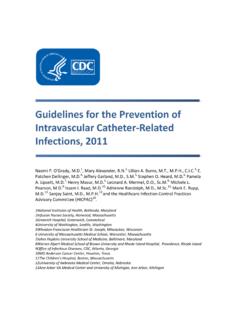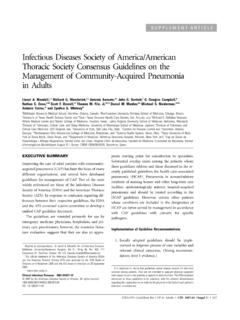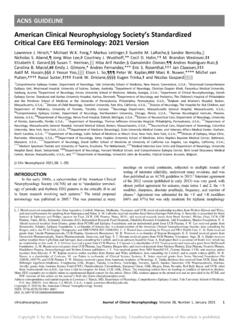Transcription of Critical Care GPICS - Home | RCSLT
1 GUIDELINES FOR THE PROVISION OF INTENSIVE care SERVICESThe Faculty of Intensive care MedicineEdition 2 June 2019 2 CONTENTS ENDORSING ORGANISATIONS .. 5 SUPPORTING ORGANISATIONS .. 5 6 SECTION 1 Critical care SERVICES: STRUCTURE .. 8 Levels of Critical care .. 9 Outcomes .. 11 Level 2 and 3 Physical Facilities .. 14 Clinical Information Systems .. 17 Clinical Equipment .. 20 Cardiothoracic Critical care .. 23 Neurocritical 27 SECTION 2 Critical care SERVICES: WORKFORCE .. 31 Medical Staffing .. 32 Registered Nursing Staff .. 36 Workforce, Induction & Training of Medical and Nursing Staff .. 40 Advanced Critical care Practitioners .. 44 Pharmacists .. 46 Physiotherapists .. 49 Dietitians .. 53 Speech and Language Therapists .. 56 Occupational Therapists .. 60 Psychologists .. 63 Healthcare Scientists Specialising in Critical care .. 66 Support Staff .. 69 3 Smaller Remote and Rural Critical care Units .. 71 SECTION 3 Critical care SERVICES: PROCESS.
2 75 Admission, Discharge and Handover .. 76 Capacity Management .. 79 Critical care Outreach and Rapid Response Systems .. 82 Infection Control .. 85 Interaction with Other Services: Microbiology, Pathology, Liaison Psychiatry and Radiology .. 88 Rehabilitation .. 91 Intensive care Follow Up .. 95 The Patient and Relative Perspective .. 98 Staff Support .. 102 Inter and Intra Hospital Transfer of Critically Ill Patients .. 105 care at the End of Life .. 109 Organ Donation .. 113 Legal Aspects of Capacity and Decision Making .. 116 SECTION 4 Critical care SERVICES: CLINICAL care .. 119 Respiratory Support .. 120 Weaning from Prolonged Mechanical Ventilation and Long-Term Home Ventilation Services .. 123 Renal Support .. 126 Gastrointestinal Support and Nutrition .. 129 Liver Support .. 133 Cardiovascular Support .. 136 Echocardiography and Ultrasound .. 138 Neurological Support .. 142 4 Burns .. 146 care of the Critically Ill Pregnant (or Recently Pregnant) Woman.
3 149 care of the Critically Ill Child in an Adult Critical care Unit .. 152 Standardised care of the Critically Ill Patient .. 156 SECTION 5 Critical care SERVICES: ADDITIONAL 159 Research and Development .. 160 Audit and Quality 163 Clinical Governance .. 166 Critical care Networks .. 169 Critical care Commissioning .. 173 SECTION 6 Critical care SERVICES: EMERGENCY PREPAREDNESS .. 176 Fire .. 177 Major Incidents .. 181 High Consequence Infectious Diseases: Initial Isolation and Management .. 184 Surge and Business Continuity Planning .. 187 APPENDICES .. 189 APPENDIX 1 GPICS AUTHORS .. 190 APPENDIX 2 LIST OF CONTRIBUTING REVIEWERS .. 196 APPENDIX 3 PROCESS TABLE .. 197 APPENDIX 4 LIST OF STANDARDS AND RECOMMENDATIONS .. 198 5 ENDORSING ORGANISATIONS Faculty of Intensive care medicine Intensive care society Association of Cardiothoracic Anaesthesia and Critical care British Association of Critical care Nurses British Burn Association British Dietetic Association Chartered society of Physiotherapists Critical care Networks Critical care Networks National Nurse Leads ICUsteps National Outreach Forum Neuroanaesthesia and Critical care society NHS Blood and Transplant Northern Ireland Intensive care society Paediatric Intensive care society Pharmacy Forum NI Royal College of Anaesthetists Royal College of Emergency medicine Royal College of Nursing Royal College of Occupational Therapists Royal College of Physicians Royal College of Speech and Language Therapists Royal College of Surgeons of Edinburgh Scottish Intensive care society society of Critical care Technologies UK Clinical Pharmacy Association UK Critical care Nursing Alliance Welsh Intensive care society Welsh
4 Critical care & Trauma Network SUPPORTING ORGANISATIONS Royal Pharmaceutical society 6 FOREWORD On behalf of the Faculty of Intensive care medicine (FICM) and the Intensive care society (ICS), welcome to the second edition of Guidelines for the Provision of Intensive care Services ( GPICS ). The first edition of GPICS (2015) was a landmark publication that built on the earlier Core Standards for Intensive care Units (2013). GPICS has become the definitive reference source for the planning, commissioning and delivery of Adult Critical care Services in the UK. Many units have found the standards and recommendations within GPICS invaluable in developing successful business cases to enhance their local services and improve patient care . GPICS has also been used as the benchmark by which local services are peer reviewed and assessed by healthcare regulators, such as the care Quality Commission (CQC). One of the challenges with producing a document such as GPICS can be the lack of a hard evidence base for some of the standards and recommendations that may be, by necessity, based on professional opinion and established practice.
5 It is therefore essential that standards and recommendations are subject to regular review and revision, as new evidence becomes available and practice changes. In undertaking this significant review and revision to GPICS , the FICM and ICS consulted widely, both with the key stakeholder organisations and through an open public survey. One of the criticisms of the first edition was the underrepresentation of authors from smaller units and the devolved nations; we have addressed this in the second edition, recognising that the majority of Critical care is not delivered in large tertiary centres. Each chapter has been written by at least two authors with expertise in the area who are, where possible, from geographically separate units. All chapters have been subject to extensive peer review and collaboration between FICM, and ICS and stakeholder organisations. The open public consultation that followed resulted in a considerable amount of constructive feedback, which has been incorporated into the final version.
6 The standards from the first edition have not been changed unless there has been new evidence presented, or widespread professional views expressed, to justify modification. The second edition focuses on service delivery, quality and safety with less emphasis on specific clinical practice guidelines. Individual chapters relating to the provision of support for each of the main organ systems have replaced the previous clinical sections. Any relevant, high quality, evidence based guidelines produced by other professional bodies are signposted within these chapters. A number of new chapters relating to service delivery, including capacity management, focussed ultrasound and serious infection outbreak have been added. Terminology describing our specialty has not been standardised with terms Critical care , intensive care and high dependency care often being used interchangeably. Within this document we have attempted to standardise and used the term Critical care when describing units and services and intensive care when referring to our specialty.
7 The role of a document such as GPICS , is to improve the standards of care that critically ill patients receive and to reduce geographical variation. Standards are musts , and are the key elements that should be used to make commissioning priorities for UK Critical care units. Recommendations are statements that the authors feel should be routine practice in UK Intensive care medicine and which are endorsed by both the FICM, ICS and stakeholder organisations. GPICS is written to assist and support units in developing their services in order that patient care is of the highest quality. For every unit, there will be some aspects of GPICS that are not currently met and we hope that units 7 will use these gaps as a driver and focus of where to develop and enhance their local service for the benefit of patient care . Peter Macnaughton Stephen Webb Chair Chair FICM Professional Affairs and Safety Committee ICS Standards and Guidelines Committee Cover photograph courtesy of ICCU, City Hospital Sunderland NHSFT Section OneCritical care Services:Structure 9 Levels of Critical care Authors: Gary Masterson & Anna Batchelor INTRODUCTION The Intensive care society 2009 Levels of care classification describes the levels of care required by critically ill patients in hospital according to their clinical needs, regardless of patient location.
8 The definitions were originally published in 20021, after the publication of Comprehensive Critical Care2 in 2000, and latterly revised to reflect the Critical care Minimum Dataset3 (CCMDS), which has been mandated since April 2006. STANDARDS 1. All patients admitted to a Critical care unit must be included in a national clinical audit programme in which Levels of care data are collected. 2. Level of care classification must not be used in isolation to decide upon a patient s staffing requirements. RECOMMENDATIONS No recommendations. BACKGROUND Level 0 Patients whose needs can be met through normal ward care in an acute hospital. Level 1 Patients at risk of their condition deteriorating, or those recently relocated from higher levels of care , whose needs can be met on an acute ward with additional advice and support from the Critical care team. Level 2 Patients requiring more detailed observation or intervention including support for a single failing organ system or post-operative care or those stepping down from Level 3 care .
9 Level 3 Patients requiring advanced respiratory support alone, or basic respiratory support together with support of at least two organ systems. This level includes all complex patients requiring support for multi-organ failure. Clinical judgement should be used to determine which level of care would be most appropriate based on the criteria in the table above. Although a lower level of care will usually require a lower 10 nurse-to-patient ratio or reduced Critical care support, this may not apply in all circumstances, and the aim should be flexibility in the provision of staff resources to meet the needs of the patient. The level of care assigned to a patient will influence, but not determine, staffing requirements. It is important to note that Levels of care classification (particularly for Level 2) is wider than the presence or absence of organ failure per se. There is ongoing work into the development of enhanced care4 in the UK and this work may lead to the modification of the levels of care in the future.
10 REFERENCES 1. Intensive care society . Levels of Critical care for Adult Patients. 2002. 2. Department of Health. Comprehensive Critical care : A Review of Adult Critical care Services. May 2000. 3. Critical care Minimum Dataset. Available from: (accessed 29 Jan 2019) 4. FICM. Critical Futures: Current Workstreams. Available from: [Accessed 29 January 2019]. 11 Outcomes Authors: Julian Bion, Dan Harvey & Nazir Lone INTRODUCTION Critical care units admit increasingly co-morbid, older patients, many of whom have high-predicted short- and medium-term mortalities with or without these therapies. Such admissions are frequently undertaken in the pursuit of patient-centred outcomes other than mortality; for example, reduction in pain or other distressing symptoms caused by surgical intervention, or a time-limited treatment trial of intensive care1 , in which both the scope and duration of therapies are limited not to restrict their benefits, but to reduce their harm.





